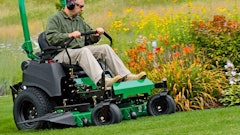
There are good reasons for landscape architects and restoration ecologists to join forces in the development of basic ecological and design principles that would be useful to inform all land-use decisions. While some have come to these professions with different training—one more heavily based on design principles, the other more heavily based on scientific principles—their aims are often aligned.
Award-winning ecologists Steve Apfelbaum, Dr. Alan Haney and Jacob Blue are studying the growing relationship between these two fields, along with the benefits of collaboration.
A shared goal is to create landscapes with ecosystems that are low-maintenance yet aesthetically pleasing, and which provide beneficial ecosystem services such as aesthetics, noise abatement, stormwater control or habitat for wild fauna, while also providing for human needs.
Much attention has been focused on the use of native vs. non-native species in projects. However, too often this debate ignores an important underlying principle of restoration: Restoration should focus foremost on restoring ecosystem functions rather than on the species.
Characteristics of healthy ecosystems
Dynamic and responsive. As conditions change, both the genetic make-up and populations of species respond, leading to domino effects in relationships between species.
Resilient. Following disturbance or sudden change in environmental conditions, individual species respond with both physiological and population level adjustments, and with corresponding changes in interactions of populations … ultimately resulting in recovery of steady-state conditions. This process, which affects all aspects of structure, composition, and functions in the ecosystem, is called succession.
Redundant. Many species have overlapping niches and perform similar functions, which contribute to efficiency, resiliency and stability.
Self-organized. Community associations reflect long-standing evolutionary relationships with each species and each association located in the landscape where it is best adapted to compete, and with remarkably similar associations in similar habitats.
Self-replicating. When disturbed, communities tend to return to the pre-disturbance structure and composition, and similar associations will develop in similar habitats if no barriers exclude key species.
Conservative. All waste is recycled and nutrients are largely retained. Any water leaving the system is relatively free of contaminants.
Operate at a hierarchy of temporal and spatial scales. Small scales of organization and functions contribute to larger scales of organization and functions.
Tend toward lowest possible energy levels. Ecosystems operate according to laws of thermodynamics, absorbing just enough energy to offset entropy when mature and undisturbed.
Continuous and open. Ecosystems exist along spatial and temporal continua, such that sharp edges are rare, although some gradients may be steep.
Functional thresholds. Some functions cease or decline at small scales such as minimal “home range” required by some species, or minimal time required for meaningful evolution or soil development.
Gradients are important. Transitions from one association or habitat to another, called ecotones, is where many functions are more common. For example, hybridization and evolution. Movement of species along gradients is also one of the important ways ecosystems remain dynamic and responsive.
Vulnerable to catastrophic disruption. Disturbances that exceed the evolutionary experience of species or communities can lead to collapse of resiliency.
Design principles
- Recognize and retain, or restore/create community ecotones with supporting environmental gradients.
- Use locally sourced native plants from the same physiographic province, or closer if the project interacts with high-quality natural areas or scientific areas.
- Manage stormwater retention, infiltration and interception within the landscape to emulate hydrographs of matched healthy ecosystems.
- Do not introduce non-native or native invasive species.
- Allow designs to be dynamic, to foster species and community shifts as conditions change.
- Create a design that results in low contaminant concentration (including nutrients) and suspended solids in runoff or infiltrating waters.
- Design plans that build and protect soil.
- Develop communities that emulate structure, composition and patterns found in local native plant communities.
- Develop designs for durability and low maintenance that require infrequent management interventions.
- Connect designs to and across landscapes following gradients and natural features.
- Provide wildlife and aquatic organisms access and appropriate habitat conditions across the landscape with continuity for safety, daily mobility, pollination, migration, foraging and breeding.
- Integrate human recreation, education, science, solitude and inspiration with restoration and management ingress and egress corridors, and with temporal and operational management needs.






























